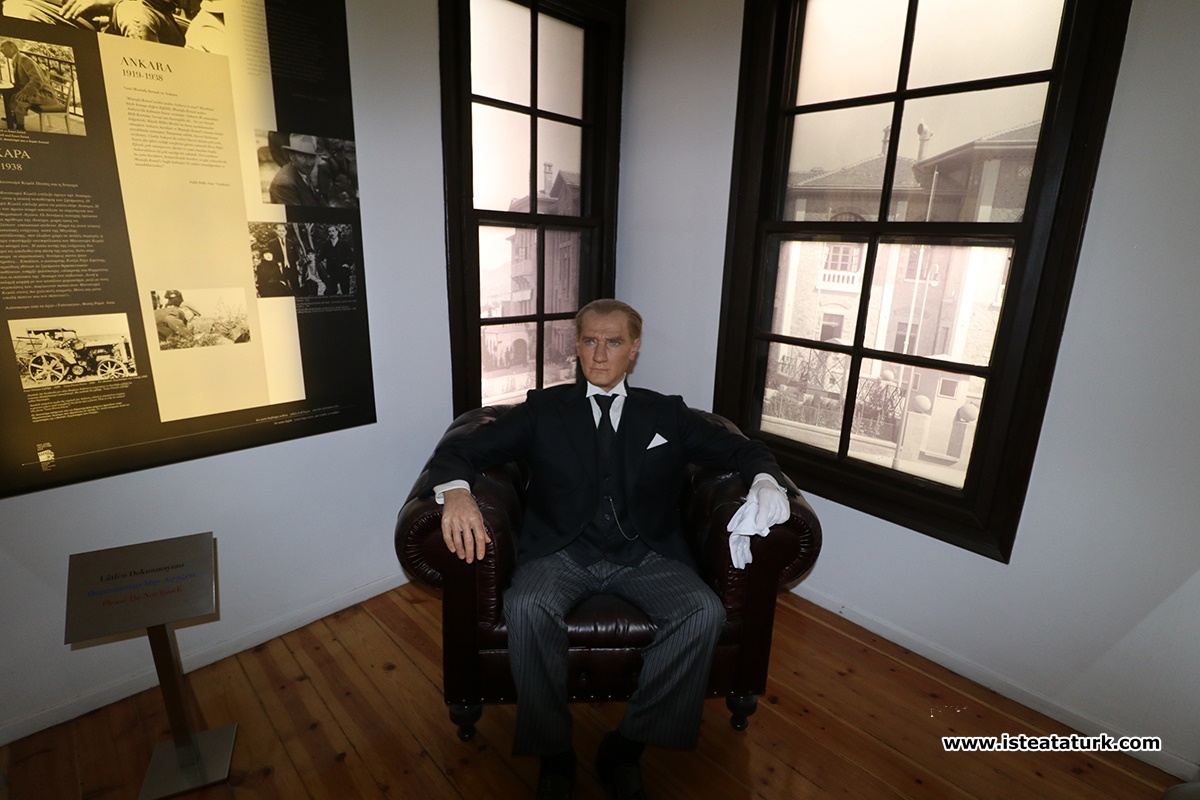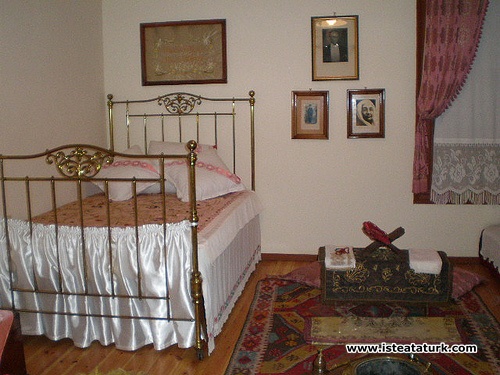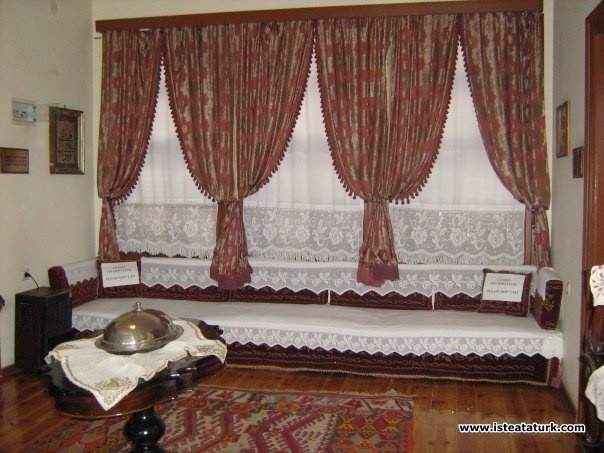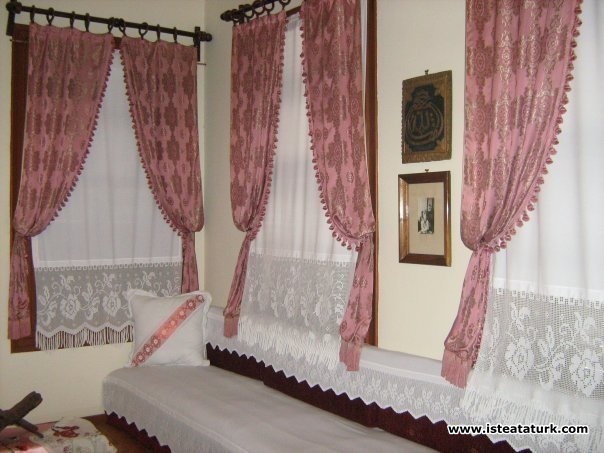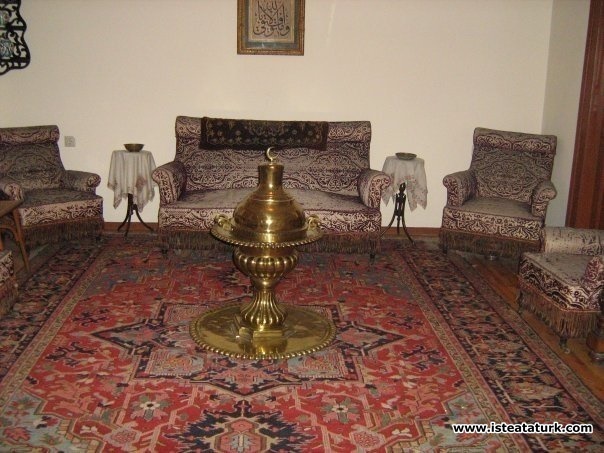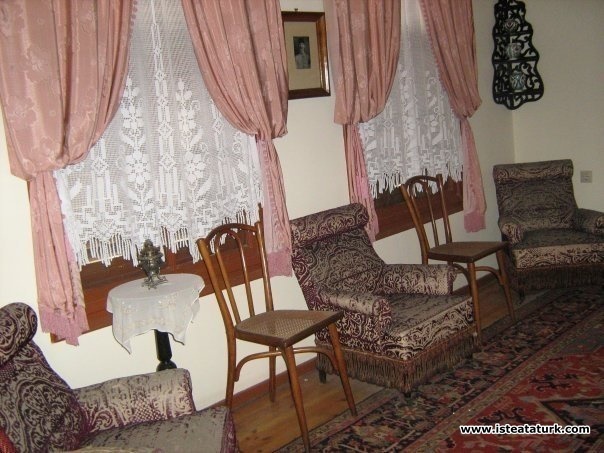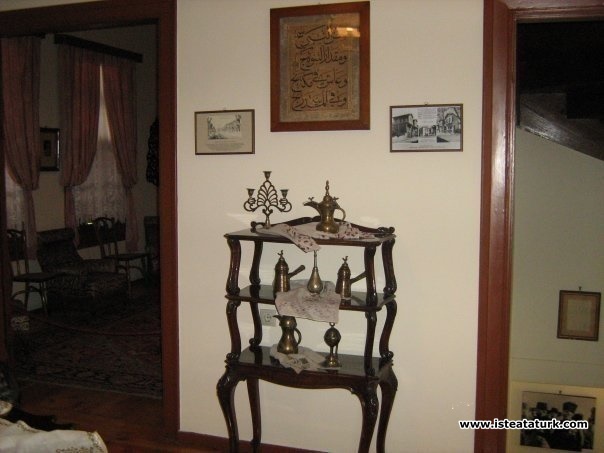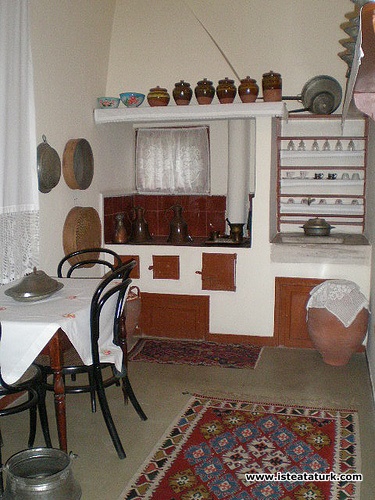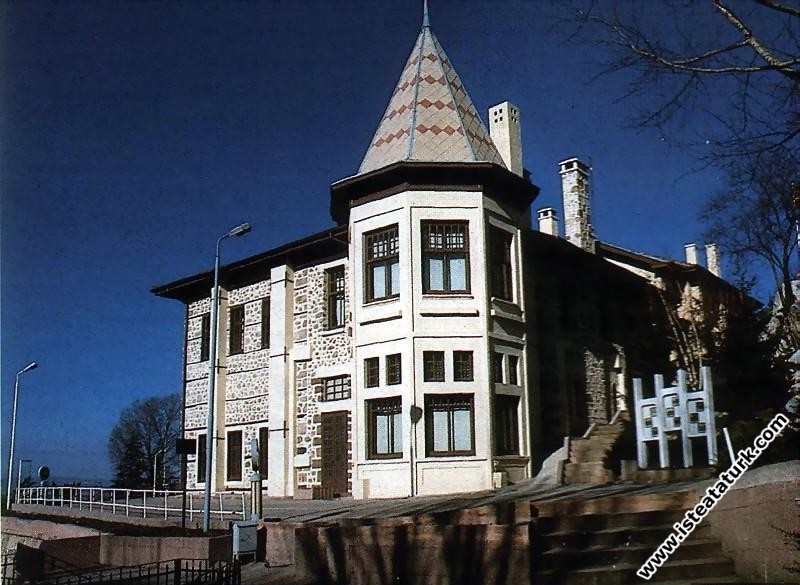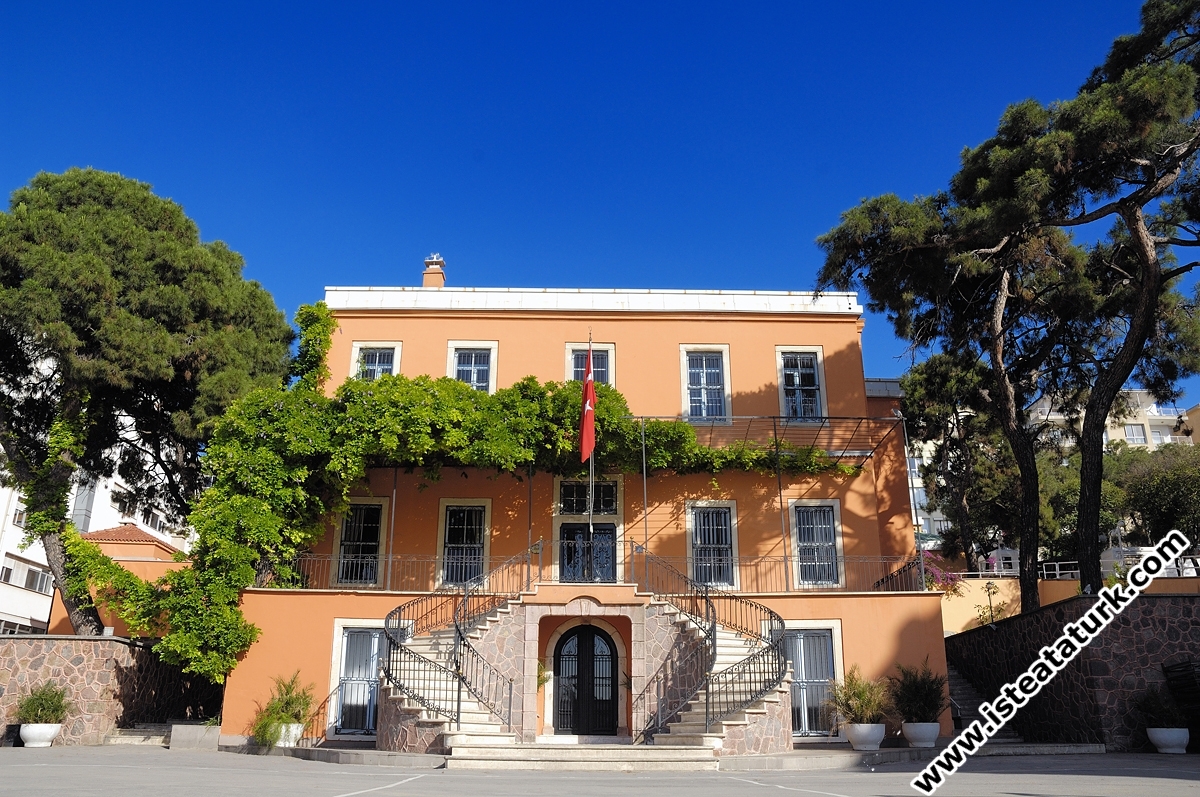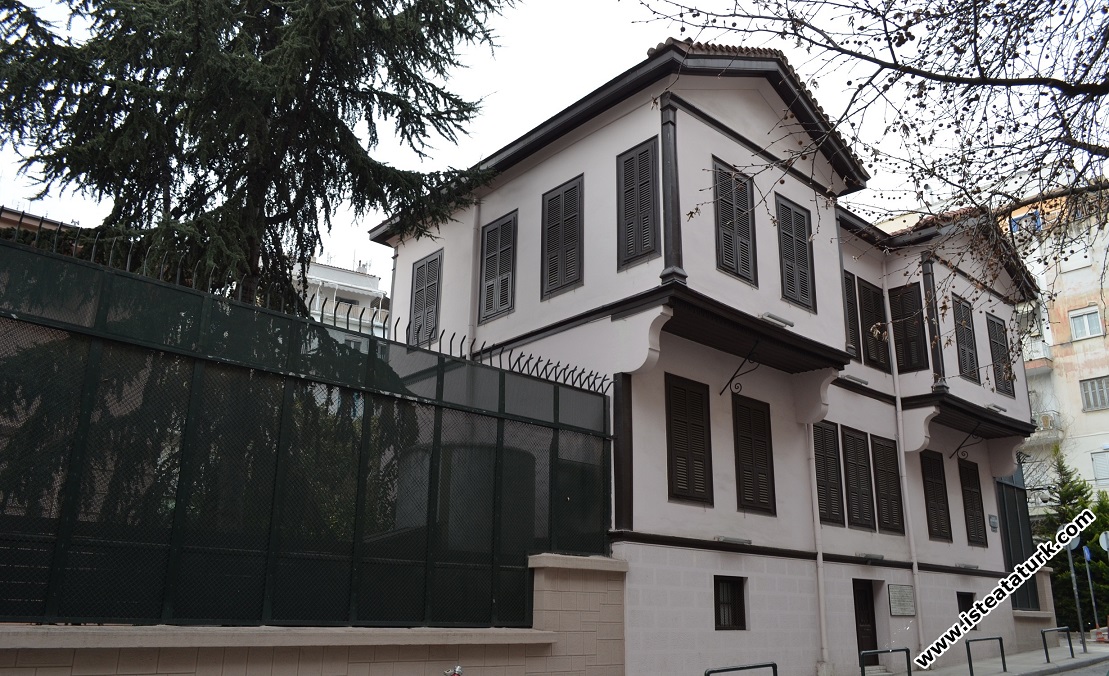
Thessaloniki - Thessaloniki Atatürk House
Character Size
Thessaloniki Atatürk House
Thessaloniki Atatürk House and Turning It into a Museum
SUMMARY
Atatürk's birthplace:
There are different opinions about the house where Atatürk was born. The first of these is that Atatürk was born in a house in Ahmet Subasi Neighborhood. The second one is the house in Islahane District (Aya Dimitri District, Apostolu Pavlu Street Number 75), which is used as a museum today.
Turning the House into a Museum: With a decision taken in 1933 on the occasion of the 10th Anniversary of the Republic of Turkey, Thessaloniki City Council gifted him the house where Atatürk was born. Atatürk wanted this house given to him to be turned into a museum. Following this, as a result of long works, the house was repaired and furnished and opened to visitors with a ceremony on 10 November 1953 under the name of “Thessaloniki Atatürk House Museum”.
The house was refurbished in 1966. However, the house, which was damaged in an earthquake in the 1970s, was repaired again. Organized for the third time in 1980, it was reopened on May 19, 1980.
Today, the house, which is a symbol of Turkish-Greek friendship, is visited by all citizens of the world.
I- The House where Atatürk was born
The date of birth of Mustafa Kemal Atatürk has been a problem that needed to be solved for a long time for researchers in the first years of the Republic. Researchers interested in the subject could not reveal the issue scientifically due to the lack of sufficient documents. Although there was an alliance over the year 1881, they encountered difficulties in determining the day and month. As a result, Atatürk, taking into account the information about his birth period; He accepted “May 19”, which has an important place in his life, as his birthday. Thus, Atatürk's birth was registered as 19 May 1881 and announced to the world1.
Another controversial issue regarding the birth period of Atatürk is the issue of the house in which he was born. This has led to various debates until today. As a result of the examinations, three houses related to Atatürk's birth and childhood years are identified.
The first of these is the house inherited from Atatürk's grandfather, Ahmet Efendi, nicknamed Kırmızı Hafız, to his father, located in the Ahmet Subaşı District2.
The second one is the house numbered 75 on Apostolu Pavlu street in Aya Dimitri District, which is used as a museum today. According to old records, this building is located in Koca Kasım Paşa Neighborhood Islahane District. The house has three floors with its basement and is in a courtyard. This building was built by the Muderris Hacı Mehmed Foundation of Rhodes before 1870 and was sold to a person named İbrahim Zühtü. Later, it was sold to Abdullah Ağa and his wife Ümmü Gülsüm from the people of Thessaloniki and rented by Ali Rıza Efendi3. The third house is the house where Atatürk lived with his family after his father's death. Atatürk spent the important days of his childhood in this building consisting of two floors, three rooms and a kitchen, which was standing in 19334. Atatürk went to school from here,
Different views on the house where Atatürk was born can be listed as follows.
1-According to Falih Rıfkı Atay; Mustafa Kemal Atatürk was born in Ahmet Subaşı Neighborhood in a mediocre wooden house opposite the Industrial School (1881). When his father, Ali Rıza Efendi, improved his business, he bought a three-storey house in the Islahane district and the family moved here5.
2-According to an opinion accepted by the majority; Mustafa Kemal Atatürk was born in a three-storey pink house rented by Ali Rıza Efendi in the Islahane district of Thessaloniki in 1878 (1881)6.
3-According to his childhood friend, Hacı Mehmed Somer (Deputy of Kütahya); Mustafa Kemal Atatürk was born in a three-storey building with pink paint on the upper two floors used as a house in Islahâne District, Ahmet Subaşı Neighborhood, which his father had built with the money he earned during his lumber business (1881)7.
4-According to Nazif Tepedelenlioğlu; Mustafa Kemal Atatürk was born in the town of Tırhala Sanjak, Tırnova, in Manastır Province during his father's civil service years. Later, when he was three and a half years old, he immigrated to Thessaloniki with his family8.
All of the opinions that provide information on this subject are people close to Atatürk. However, this information is based on memories. The fact that the memoirs were written after a long time and that they were mixed with other information causes divergence of views on this issue. However, despite the differences, it is possible to find common points between these views. These common points are also compatible with Mustafa Kemal Atatürk's biography. According to this, Atatürk's father, Ali Rıza Efendi, was working as a customs officer in the Papasköprü locality in Katarin Town, at the foot of Mount Olympus, near Thessaloniki, before he got married. Ali Rıza Efendi was living in his father's house in Ahmet Subaşı District in Thessaloniki when he married Zübeyde Hanım. Ali Rıza Efendi, who earned little money as a civil servant, He became a partner with the Thessaloniki timber merchant Cafer Efendi and when he started to earn good money, he left the civil service and settled in a three-storey building in Koca Kasım Paşa Mahallesi Islahâne District (Aya Dimitri Mahallesi Apostolu Pavlu Caddesi). During this period, a child named Mustafa was born to the couple Zübeyde-Ali Rıza.
As for the separated points: The first is the issue of which of the two houses in Thessaloniki where Mustafa Kemal Pasha was born. The other is the claim that Mustafa Kemal Pasha was not born in Thessaloniki9.
It is highly probable that the most convincing view here belongs to Falih Rıfkı Atay, who was with Atatürk for a long time. According to this; The house where Atatürk was born should be in Ahmet Subasi Neighborhood. The building, which is used as a museum today, is the house where the family lived for a while and there are various disagreements about whether it was bought or built or rented by Ali Rıza Efendi after his birth. According to the examinations, the house is more likely to be rented, and there is information that it was later bought by Atatürk during his junior officer years10. As a matter of fact, after Ali Rıza Efendi's death in 1888, the family left this pink house and moved to a smaller house right next to it in order to alleviate their living expenses1'.
While Atatürk was in this house, he first enrolled in the Thessaloniki Civil High School, and left here in 1893 and transferred to Thessaloniki Military High School. His mother married Ragıb Efendi here. Young Mustafa Kemal stayed with his aunt for a while, making this marriage a matter of pride, even though his stepfather was a very good person. Later, he left Thessaloniki for his school life and went to Manastır. Mustafa Kemal, who graduated from the Military High School here, came to Istanbul in 1896 and started the Military Academy12. It is known that he came to his mother to spend his summer vacation during his student years and they stayed in this small house.
Before the proclamation of the Second Constitutional Monarchy (1907), Mustafa Kemal Atatürk, who was in charge in Thessaloniki, bought the large pink-painted house where they lived before, and lived here with his family, and many political meetings were held here13. His mother, Zübeyde Hanım, lived in this house until the end of the Balkan War and came to Istanbul after the Greek occupation of Thessaloniki and settled in a house in Beşiktaş Akaretler14.
With the occupation of Thessaloniki, both houses where Atatürk and his family lived remained within the borders of Greece. The fate of the houses in the following period is not known until 1923. Finally, the houses will be left to Greece in accordance with the Treaty and Protocol on the Exchange of Turkish and Greek Populations of the Lausanne Peace Treaty (24 July 1923). According to Article 7 of the relevant Protocol, Mustafa Kemal Pasha's mother and brother, although they had left Thessaloniki beforehand, were considered exchanged and could receive equal value from the exchanged houses in Turkey in return for their properties in Greece15. As a matter of fact, Mustafa Kemal Pasha's family was given a mansion in Bebek in return for these houses in Istanbul. This mansion was given to his sister Makbule Atadan by Atatürk in the 1930s, on the condition that he does not claim any rights from the houses of Thessaloniki16.
II- Turning Thessaloniki House into a Museum
A- Decision of Thessaloniki Municipality
In the first years of the exchange, a Greek named Apostolos Afamopulos lived in the house as a tenant17. From whom did Afamopulos rent the house? There is no information on this subject. Probably the house, according to the Exchange Protocol provisions in this period; It was transferred to the National Bank of Greece and leased there. In the 1930s, the house was purchased from the National Bank for 200,000 drachmas by an exchanged Greek woman from Turkey named Sarabini and is used by four exchanged families from Trabzon18.
After the Treaty of Lausanne (July 24, 1923) between Turkey and Greece, there was an "exchange issue" as an important disagreement. The source of the problem was the legal meaning of the term "etablised/settled". Turkey wanted the etabli issue to be resolved according to Turkish laws. Greece, on the other hand, insisted that everyone who was in Istanbul before October 30, 1918 be considered settled. The matter was taken to the League of Nations, the International Court of Justice. However, it could not be solved with the comment of this place. Finally, the parties signed an agreement on the subject on 1 December 1926. This time, the tension between Turkey and Greece increased due to the disruptions in the implementations and the winds of war began to blow between the two states. The job of easing this tension fell to Greek Prime Minister Eleftherios Venizelos. Like this, With a new agreement signed on 10 June 1930, an important Turkish-Greek conflict that had been going on for seven years ended, and a new era began in Turkish-Greek relations19. Upon the invitation of the Turkish Government, Venizelos visited Turkey on 27-31 October 1930. During this trip, three agreements on military, commercial and friendship were signed on October 30, 193020. A year later, Turkish Prime Minister İsmet İnönü and Foreign Minister Tevfik Rüştü Araş visited Greece21.
The Turkish-Greek friendship that progressed in this way was instrumental in laying the foundation of the Balkan Entente, depending on other developments in the World and especially in Europe. At the meeting of the World Peace Congress Association held in Athens in 1929, the idea that a lasting peace in the Balkans was needed was put forward. This idea was first developed between Turkey and Greece and was accepted by other Balkan states. As a result of subsequent negotiations, the Balkan Entente was signed on February 9, 193422.
At the center of this friendship lies Atatürk's principle of “Peace at Home, Peace in the World”. His peaceful policy had given its first fruits in terms of international law in the early 1930s and brought the Balkan States together. In the same years, there would also be a development concerning Atatürk's personality. This development is the desire to donate their house in Thessaloniki, where he lived his childhood memories, in the 10th Anniversary of the Founding of the Republic.
The Municipality of Thessaloniki, at a special meeting held on 29 October 1933, the anniversary of the establishment of the Republic of Turkey, on the occasion of the 10th anniversary of the Republic, a commemorative plaque was placed on the wall of the house where Atatürk was born in Thessaloniki, and it was purchased from the current owners of the house, Mustafa Kemal Pasha. He decided to give it as a gift. As a matter of fact, although the plate was nailed to the wall on the same day; The relevant ceremony was left for the delegates of the Balkan Entente to arrive in Thessaloniki. The sign reads, “Gazi Mustafa Kemal, the great mujaddid of the Turkish nation and the promoter of the Balkan Union, was born here. This plate has been placed on the occasion of the tenth anniversary of the Republic of Turkey. Thessaloniki, 29 First Term 1933”. Later, this phrase was engraved on marble in Turkish, Greek and French24. IV. The Balkan Conference was to be opened in Thessaloniki on 5 November 1933.
The Thessaloniki City Council's decision to purchase the house was notified to the Turkish Consulate General in Thessaloniki as follows25: “Greek Republic of Thessaloniki 30 Second Dec. 1933 Municipality of Thessaloniki Registration No: 50684 To the Reverend Selim Feyzi, Consul of the Turkish Republic, Consul in the City, Gentleman, the tenth anniversary of the Republic of Turkey On this occasion, the decree of our Municipality Council, numbered 488 and dated 29 First Announcement, 1933, containing the decision about the purchase of the house where the glorious Gazi Mustafa Kemal, who is the President and the Founder of the Republic of Turkey, was born, and the valuation of a commemorative plaque on its wall, was sent to your Excellency. and I have legitimacy. This decree, Thessaloniki, I request you to signify and intercede to present the decree to His Holiness the President, together with the declaration that this is only a small part of the appreciative and sincere feelings of the people of Thessaloniki, who acquired honor and pride as it was the city where His Holiness Ghazi was born. I hereby ask you to present our sincere wishes for health and well-being to His Excellency the Musharunilelyh of the people of Thessaloniki and to the friendly Turkish nation, and for the permanent happiness of the friendly Turkish nation, and I would like to present my honor to His Excellency.
(Seal)
Mayor of Thessaloniki Monsieur Apostol Cosmopido
(Signature)"
B- Ceremony (November 4, 1933)
The plate affixing ceremony of Atatürk's Thessaloniki House took place on November 4, 1933, with the arrival of the Balkan Entente Delegation26. Deputy Speaker of the Greek Parliament, Governor General of Macedonia, Mayor of Thessaloniki and Members of Parliament, Turkey's Ambassador to Athens Enis Akeygen, the President of the Balkan Conference Pope Anastasia and the Balkan Conference Turkish Executive Members and some high-level members attended the ceremony. At the ceremony, the President of the Balkan Conference Anastasya made a speech and explained the role of Mustafa Kemal Pasha in the solidarity of the Balkan nations. Anastasia's speech was as follows27:
“...Mustafa Kemal is not only the leader of a friendly nation, but also the most vigorous defender of the idea of unity of the Balkan nations, by being able to save his homeland and perfecting the Turkish nation and making it possible to associate with all other Balkan nations, and for its history, social, reform and freedom. This city of Thessaloniki, which is full of struggles, is proud and proud to see Mustafa Kemal among his own children, the fact that Mustafa Kemal was born in Thessaloniki himself was in Ankara. All Balkan nations are of the same origin. We are so mixed with each other; we form a national family, the record of which proves how meaningful his words are; In this way, every Balkan nation, from the glory and fame of Mustafa Kemal, who has been eternally deserved to humanity,
C- Buying the House
Thessaloniki Municipality decided to buy the house from the owners in the same year (1933) and allocated 300,000 drachmas from the budget of that year for this work. Municipal officials met with the owner of the house, an exchanged Greek named Sarabini. However, the landlord found the money offered too low, saying that he had bought the house for 200,000 drachmas and had spent 200,000 drachmas in it. Thereupon, the bargaining dragged on and no progress could be made between 1933 and 1935. This delay caught Atatürk's attention. Atatürk warned the Ministry of Foreign Affairs and demanded that the process be accelerated. Acting with this directive, the authorities sent a letter to the Consulate General of Thessaloniki on September 25, 1935. He demanded that “if the house cannot be expropriated by the Municipality of Thessaloniki, the municipality and the owners should be contacted so that it can be bought by the Attorney's Office”.
Upon this attitude of Turkey, Thessaloniki City Council decided to expropriate the house on 19 October 1935. However, for the relevant expropriation decision to come into effect, a temporary law had to be enacted by the Greek Parliament. The Greek Ministry of Culture found the formula "Monument Historique (Historical Monument)" for the relevant law. For this purpose, the 7th paragraph has been added to the 12th article of the “Law No. 4108”. This paragraph; It contained the provision that “even all kinds of real estate and property, which are located in a city plan or a village and have national historical importance and constitute an important work and memory for the history of the country, can be expropriated for the municipality and village”29. Thus, the legal procedure was completed and it was time to implement the decision.
The municipality realized the transaction on April 8, 1936, by allocating the necessary allowance for the expropriation of the house, in accordance with the compulsory expropriation law. However, the amount given to the house was found to be low by the owners. The landlord will report themselves to the newspapers. She said that she would complain to the Society of Emigrants and if not, she would meet with Mustafa Kemal Pasha. As the local elections were approaching, the Mayor could not afford the backlash and offered 400,000 drachmas to the landlord. The landlords put the matter in stubbornness and did not accept this amount. Finally, with the intervention of the Turkish Consulate General, a compromise was reached on September 19, 1936, and the house could be purchased for 650,000 drachmas. This time, the Governor General of Macedonia found the amount paid to be excessive and ordered the cancellation of the purchase and the payment of the old expropriation price. This meant turning the matter over again and dragging it into a drag.
According to the contract; The building was to be evacuated and handed over in two months. However, despite the expiry of the relevant time, the residents did not evacuate the building. As a matter of fact, the Turkish consulate stepped in again and another 10,000 drachmas were given to the concerned and the problem in this matter was resolved. On February 12, 1937, Thessaloniki Mayor Merkuriyu sent the following telegram to Atatürk, expressing his satisfaction with the completion of the proceedings. The relevant telegram text was as follows30:
“The council of the city where they were born is honored to keep the memory of the great creator of New Turkey, the sincere friend of our country, in the house where he was born, and to make the historical house available to its orders as a sign of extraordinary honor from this day forward”
In addition, Merkuriyu stated that he wanted to present the title deed by coming to Ankara himself. This desire of his was not deemed appropriate, as it was stated that Mustafa Kemal Pasha was constantly on tours of the country31 and he was requested to send the relevant documents through the Athens Embassy. Mustafa Kemal Pasha also gave a gold monogram and a silver frame photograph to the Mayor and Macedonian General Governor as a gift (29 April 1937)32.
Finally, the building was evacuated on February 19, 1937, and the keys were handed over to the Consulate General in Thessaloniki33. This event was also covered by the Turkish newspapers of the period34.
The letter of the Municipality of Thessaloniki to hand over the key to the house is as follows35:
“Mr Consul, Thessaloniki 13/2/1937
It would be my honor to inform you that the house numbered 71, located on Apostolic Pavlu Street, where the President of Turkey, Kemal Atatürk, was born, was presented to them by the decision of the Thessaloniki Municipal Council, dated 1936 and numbered 814. This decision, which was approved by the letter numbered 149341-36 of the Macedonian General Governor's Office, has come to the fore with the evacuation of the house by the people living in this house. The Municipality has notified His Excellency the President of Turkey with the telegram yesterday that he has made it available to his orders.
I would like to send you the key to the house in question to present you the official donation in accordance with the foundation and pay my deepest respects.
Mayor of Thessaloniki
(signature) Merkuriyu "
D- Restoration of the House
Atatürk's Thessaloniki house should have been restored in a personal way after it was handed over to the Turkish authorities. As a matter of fact, this point has been considered beforehand. President Atatürk sent Presidential Secretary General Ruşen Eşref (Ünaydın) Bey and Afet İnan Hanım to Thessaloniki for some preparations to be made at a time when the acquisition process is still in progress. Although these people had the opportunity to visit the house in 1933 through the Consulate, they could not get enough opportunity to examine the house because of the exchanged families36.
Three different plans were drawn at different times for the restoration of the house. The first plan was drawn up by the Thessaloniki architect Emmanuel Melanos. The basement in the building is not shown in this.
According to the Plan of February 16, 193737
First floor
a-A sofa
b- Ablution room
c-Shelf
d-Kitchen
e-A room next to the kitchen
f-A room across from it
g-The secret cellar adjacent to it. Second floor
a-A sofa
b- A cellar
c-A terrace made of Maltese stones d-The room where Atatürk was born
e- A room across from it. However, the implementation of this plan was not possible. Meanwhile, Atatürk had passed away. The second plan was made by Turkish engineers on 17 June 1939. For this job, the Nafia Ministry appointed two engineers named Abdullah and Ergun. These individuals prepared a plan again. According to the plan dated June 17, 193738 Basement Floor (Today the first floor)
Three shops Ground Floor (Today the second floor) a-Sofa
b-Kitchen c-A room next to the kitchen d-A room across from it e-Storage room adjacent to it f-Shelf
First Floor (Today the third floor) a-Sofa b-Abdesthâne
c-Terrace made of Maltese stones
d-The room where Atatürk was born, e-A room across from it. The third plan is dated 8 July 1919. During the preparation of this plan, interviews were held with people who knew the house closely. The names of these people were:
1- Mustafa Haci Osman is a resident of Aya Dimitri Street, house number 196. Atatürk's former neighbor.
2- Apostolos Afomapulos was a tenant in the house in 1925.
3- Architect Emanuel Melanos, The person who made the first plan.
According to the plan dated July 8, 193939 Basement Floor
a- A room on the right
b- A room on the left
c-A sink
Ground Floor (1st Floor of the House)
a-Sofa
b-Kitchen
c- The room adjacent to the kitchen
d-A room opposite this and the adjacent storage room
e-Shelf
First Floor (2nd Floor of the House)
a-Sofa
b-Abdesthane
c- A terrace of Maltese stones
d-The room where Atatürk was born e-A room across from it
Based on these plans, it was decided to repair the house. The restoration work was given to contractors named Yani Yorgadis and Eli Modiano from Thessaloniki for 10,056,000 drachma40 on May 3, 1940. Although repairs were started five days after the agreement, II. The severity of World War II and the German occupation of Greece led to unfinished business. The contractors also quit. After this date, repairs were interrupted for a long time. Finally, the restoration was completed in 1950.
E- The Matter of Furnishing the House
1) Furnishing of the House in 1953 After the completion of the repair of the house, its furnishing came to the fore. The furnishing of the house was given great importance in this period, as the Turkish works in Greece were destroyed and the Turkish traces in Thessaloniki were wanted to be erased. On this occasion, Atatürk's Thessaloniki house was considered as a monumental neighborhood that would keep alive the past of Turkishness in Macedonia and Thessaloniki as well as his great name. Atatürk's House was seen as a bridge, a material and spiritual bond connecting the past, future and reforms of the Turks to the homeland, beyond the borders of the National Pact41. For this purpose, the Ministry of National Education established a commission consisting of Atatürk's sister Makbule Atadan, Afet İnan, Hayrettin Örs and an official to be selected from the Ministry. Ms. Makbule did not join the delegation42. Other members went to Thessaloniki to determine the items to be put in the house and their locations. The relevant Commission completed its work and submitted it to the Ministry as a report. However, no results were achieved until 1953. Thereupon, the then President Celal Bayar seized the matter and held a meeting with the authorities on 28 January 1953. This meeting was attended by the Speaker of the Turkish Grand National Assembly (TBMM) Tevfik Koraltan, the Minister of National Education (MEB) Tevfik İleri, the Members of Parliament Keçecizade Salih, the Zuhuri Consultants and the President of the Turkish Revolution History Institute (TİTE). Dr. Enver Ziya Karal attended. The following decisions were taken at the meeting43: He seized the matter and held a meeting with the authorities on January 28, 1953. This meeting was attended by the Speaker of the Turkish Grand National Assembly (TBMM) Tevfik Koraltan, the Minister of National Education (MEB) Tevfik İleri, the Members of Parliament Keçecizade Salih, the Zuhuri Consultants and the President of the Turkish Revolution History Institute (TİTE). Dr. Enver Ziya Karal attended. The following decisions were taken at the meeting43: He seized the matter and held a meeting with the authorities on January 28, 1953. This meeting was attended by the Speaker of the Turkish Grand National Assembly (TBMM) Tevfik Koraltan, the Minister of National Education (MEB) Tevfik İleri, the Members of Parliament Keçecizade Salih, the Zuhuri Consultants and the President of the Turkish Revolution History Institute (TİTE). Dr. Enver Ziya Karal attended. The following decisions were taken at the meeting43:
1- Reviving the historical atmosphere in the ceremony of the house,
2-Using original items,
3-Procurement of the goods from the existing palaces and Atatürk's personal belongings,
4- Turning one of the rooms into a museum belonging to Atatürk,
5-Completion of the works as soon as possible,
6-Send Enver Ziya Karal to Thessaloniki to inspect the house.
President Celal Bayar, from these decisions, especially focused on the completion of the works as soon as possible. Because, although this issue has been on the agenda since 1933, it could not be completed until then due to various reasons and obstacles. Now this work had to be finished as soon as possible. As per the decision taken, EZ Karal went to Thessaloniki on February 5, 1953 and started working. His work here took eleven days (6-16 February 1953). Later, he visited Turkish houses in Xanthi and Komotini (17-19 February 1953). He also visited the Kavalalı Mehmet Ali Pasha Mansion, which was turned into a museum by the Egyptian Government44 to gain information. He came to Istanbul and met with those who knew the old state of Atatürk's house. Then he returned to Ankara (28 February 1953)45.
The people whose opinions were consulted in Greece and Turkey during this trip are as follows:
1-Mustafa Hacı Osman is a resident of Thessaloniki Aya Dimitri Caddesi 186 and is Atatürk's neighborhood friend.
2-Fehmi Ali Sergeant Paçka lives on Langada Street in Thessaloniki, is a tradesman, and knows Atatürk from his officer years.
3-Mehmet Ali Bolin, Consul General in Thessaloniki, knows the old version of Atatürk's house.
4-Apostolos Afanopulos was a tailor on Aya Dimitri street in Thessaloniki and lived as a tenant in Atatürk's house after 1923.
5-Emanuel Melanos (Engineer), lives in Pavla Mela street, made the plan of the house in 1937.
6-Nafia Olcay is a relative of Atatürk and knows her house in Thessaloniki.
7-Adviye Tezel lives in Istanbul, her neighbor from Thessaloniki.
8-Hasan Rıza Soyak is a resident of Istanbul and is Atatürk's first secretary.
The following are the Turkish houses visited and inspected for property identification:
1- Tahir Yörük's House in Xanthi,
2- İbrahim Ahmet Bey's House in Komotini,
3- Ahmet Ağa's House in Komotini,
4-Kavala Mehmet Ali Pasha Museum,
The persons interviewed for the determination of the household goods used forty and fifty years ago in the cities of Rumelia:
1-Tahir Yörük in Xanthi,
2- İbrahim Demir in Xanthi,
3-İbrahim Ahmet in Gümücine,
4-Faik Active in Komotini,
5-Osman Üstüner in Komotini,
6-In Thessaloniki, Prof. Dr. Stifon Kyriadidis, Head of the Folklore Institute of the University of Thessaloniki,
7-In Thessaloniki, Prof. Dr. Vakalopulos, Lecturer in Modern History, University of Thessaloniki.
EZ Karal, who gathered the necessary information as a result of the researches, returned to Ankara on February 28, 1953 and presented a report to the Ministry of National Education about his studies. This was followed by other reports related to the course of the studies.
Furnishing of Atatürk's Thessaloniki House I. Report (28.02.1953)46 A-Purpose and procedure, B-History of the house, 1-The house was gifted to Atatürk by the Municipality of Thessaloniki, 2-The house was repaired and reinforced by the Turkish Governments, C-The house was furnished Furnishing, 1-Today's appearance, 2-Separation of the rooms of the house according to the service they have seen before, 3- Furnishing the rooms according to the service they have received,
4-Some issues that are thought to be appropriate to be made after one of the rooms is turned into an Atatürk museum, D-The house is furnished and turned into a museum,
E- Attachments
This report was negotiated at the Ministry of National Education on March 9, 1953, under the presidency of President Celal Bayar. After the negotiations, the report was approved and a new report was asked to be prepared on where to obtain the necessary goods47. As a result of the investigations, the new report was prepared on March 27, 1953. The report included possible items and their estimated costs. Furnishing of Atatürk's Thessaloniki House II. Report (27.03.1953)48
Part I: Curriculum and estimated cost of the furniture required for the furnishing of the rooms,
Part II: The places where the goods are supplied, Part III: The goods necessary for the furnishing of the house,
Chapter IV: Alphabetical list of goods,
V.Part: Museum room furniture,
According to this report, the Estimated Costs for Furnishing the House were as follows:49:
Servant's room: 352 lira
Pantry: 338 liras
Sofa: 1,744 lira
Cuisine: 397 lira
Dining and living room: 1,599 lira
Guest room: 2,408 lira
Sofa: 1,289 lira
Ataturk's room: 1909 lira
Total: 10,036 liras
At the meeting on March 27, 1953, the second report prepared was discussed and approved, and it was requested to proceed to the procurement of the goods. Upon this order, EZ Karal immediately started his studies and made investigations. Within the framework of these examinations and contacts, the Ethnography Museum was visited in Ankara, and contacts were made with the General Directorate of Sümerbank and the General Secretariat of the Republican People's Party. In Istanbul, he visited the Provincial Directorate of National Education, Capa Girls Institute, Atatürk Girls' High School, Topkapı Palace Museum, Şişli Atatürk Museum and Dolmabahçe Palace. It was determined where the goods are located and how they will be procured. Lists of items were made and efforts were made to obtain them as a result of necessary correspondence. The report on the subject was submitted to the Ministry on 3 September 1953. Furnishing of Atatürk's Thessaloniki House III. Report (03.09.1953)50
A- Contacts made in Ankara for necessary goods,
B- Searches made in Istanbul for the necessary goods,
C - Appendices.
Upon the submission and approval of the report, it was decided that EZ Karal and his wife, Fatima Hanım, would go to Istanbul and Thessaloniki to make the final preparations. The Karal family, who stayed in Istanbul between September 15 and October 7, tried to supply the missing fabrics for armchairs and sofa faces, some necessities such as lace, cushions, and books to be taken to Thessaloniki. They also followed the customs affairs and ensured that the goods were placed on the wagons. When the work in Istanbul was finished, the family went to Thessaloniki and took charge in the placement of the goods.
EZ Karal stayed in Thessaloniki from 9 October to 12 November and furnished the building. With a ceremony held on November 10, 1953, the anniversary of Atatürk's passing into eternity, the building was put into service as the “Thessaloniki Atatürk House”. These studies were also submitted to the ministry in the form of a report. This was the last report. Furnishing of Atatürk's Thessaloniki House IV. report51
A) Preparations made in Ankara,
B) Studies carried out in Istanbul,
C) Studies in Greece,
D) The current state of the house, which was turned into a museum,
E) Expenses for furnishing,
F) Thoughts about the future of the museum,
G) Attachments related to all these works,
Annex-1) A letter for the delivery of goods from the Dolmabahçe Palace to the GNAT Administrative Headquarters,
Annex-2) Photos provided for Thessaloniki Museum,
Annex-3) List of goods delivered from the Republican People's Party to the Turkish Revolution History Institute, Annex-4) Goods purchased through Topkapı Palace,
Annex-5) Letter for changing the faces of armchairs and sofas,
Appendix 6) List of items received from Topkapı Palace,
Annex-7) Customs list of the goods,
Annex-8) Expenses incurred for goods purchased in Istanbul, Annex-9) Expenses incurred in Thessaloniki,
Appendix-10) The Fixtures Book of Atatürk House,
Annex-11) Atatürk's Testament,
Annex-12) The chronological list of the works carried out to turn Atatürk's house in Thessaloniki into a museum,
According to this report, which contains very detailed information about the works carried out, the cost of furnishing the house is stated as follows.
Cost in Istanbul: 2.263 liras
Expenses made in Thessaloniki: 2.280 liras
Total: 4.943 liras
If the estimated cost in the second report is compared with the actual cost, it is seen that there is more than half of the estimated cost. To focus on the reasons for this, some of the goods could not be found for various reasons and could not be purchased, and some of them were purchased from state institutions at an extra cost. Here, there is a big difference.
1953 Furnishing of the House 52
a- First Floor
Taşlık: The floor of the gizzard, which is entered through the street door, is made of maltese stones, so the floor was not paved separately. An oil lamp is hung on the wall to the right of the door opening to the garden. A pitcher and basin were placed in front of the sink. Signs in Turkish and Greek were hung on the walls, stating that things should not be touched.
Pantry: Along the wall to the left of the door, there is a chest of grains, a sieve and a sieve, a meat log, a knife, an ax, pots and a jar. Along the wall opposite the door, there are boats, bread bowls, trays, trays, and pans. Along the wall where the door is located, there are cauldrons, copper pots and some items. Servant Room: The floor of the room is covered with mat. There is a grass cushion along the window opposite the door and a skin on it. Along the wall to the left of the door, there is a sofa (2,30x0,80 m.). The cedar and the pillows on it are covered with dark fabric. To the right of the door is a storage chest (0.98x0.50 m) and a mattress, quilt and a colored blanket were placed on it. There is a water jug in one of the windows, a mug in the other, and a colored lantern in the last one.
b- Second Floor
Sofa: The floor is paved with a wide Sarköy rug (4.35x3.90 m.). The kilim has a serrated core like a saw tip with black and white, beige, brown, green, red and gray colors on a red background, and there are stylized shapes on the other parts. On the windows of the sofa facing the street and the garden, there are calico curtains and silk fabric curtains embroidered with yellow leaves and blue flowers on a red background. The sofa in front of the window and the pillows on it are covered with the fabric of the curtains. There are calico covers with lace edges on them. In the middle of the sofa, there is a black mahogany table and a cover with Rumeli style embroideries on it.
There is a closet opposite. It has two wings, three drawers and a mirror. Hazeran chairs are lined up along the wall. There is an oil lamp hanging on a hook in the middle of the ceiling.
Kitchen: There are copper-tinned pots and dishes placed on the shelves.
Living and Bedroom: Atatürk's mother's living and bedroom rooms, which open to the sofa and are adjacent to the kitchen, are modestly furnished. A rug (3.30x335 m.) was laid on the ground. In front of the three windows facing the street, there is a Rumelian style sofa and a brass double bed leaning against the wall on the left. A red cover is covered on the bed of the bed, and the white sheets and laces hang down. At the head end, there is a plate with the Quran and religious writings next to it. There are two floor mats on the floor and a barbecue on it. At the foot of the bed, there is a chest covered with a blue cover embroidered with flowers. The windows are covered with calico fabric curtains. There is a covered ottoman in front of the window.
Guest Room: A large Sarkoy rug (3.0x2.50 m.) is laid on the floor. The rug contains green, black and white stylized motifs. There is a brass brazier in the middle of the room. On the right wall of the room is an ornamented console with five drawers. Above the console stands a gilded mirror. Two blue watermelon lamps, a jug and a glass are placed in front of the mirror.
Along the wall facing the door, there is a sofa covered with fabric and four armchairs placed on its right and left. In front of the seats, old-style sepha are placed. There is a wall shelf to the right of the sofa and a vase in each of the three compartments. There are flowery circles on the sepha.
A clock with the brand K(emal) A(tatürk) was mounted on the wall on the left side of the door, tulle and fabric curtains were placed on the windows. Old Turkish plates embroidered with colored thread on silk are hung on its wall.
An oil lamp hanging on a hook in the middle of the ceiling completes the decor of the room.
c- Third Floor
Sofa: A wide Sarköy rug (3.90x3.50 m.) is laid on the floor. The rug resembles the motifs of the rug placed on the second floor sofa. In the middle of the sofa, there is a table with a flower bed and a Rumelian oil bowl.
Along the wall opposite the staircase is a wall console with a marble top and gilded sides and feet. There is a mirror with gilded edges on the console, and a brass oil lamp stands in front of the mirror.
A basin and a pitcher were placed next to the gusûlhâne door of the hall.
A chest and hazeran chairs are lined up on the other wall. In front of the windows facing the street, a Rumelian style sofa and curtains are made of floral fabric. Cedar covers and pillow covers are from the fabric of the curtains.
Atatürk Room: A large Berkofça rug (3.86x2.82 m.) is spread on the floor. A large (4.40x3.15 m.) Turkish Flag has been hung from the ceiling to the floor on the wall to the right of the entrance. In front of the flag, there is a bronze bust of Atatürk (0.90 m.) on a wooden pedestal. To the left of the bust, a notebook was placed on a table covered with blue broadcloth to write down the thoughts of those who visited the house.
In the middle of the room, a pedestal barbecue and hazeran chairs are lined up along the walls. The curtains of the windows consist of two parts. The first is calico with lace ends and the other is red satin with embellishments. The sofa placed in front of the window is made of the same colored fabric, and the pillowcases are covered with the same fabric with lace edges.
There is an oil lamp with a white brass lampshade suspended from a hook on the ceiling.
Museum Room: The floor of the room was left empty in order to draw attention to the belongings. The windows are fitted with calico curtains. Thus, a dim light from outside is also provided to the room.
There are four showcases, a book shelf and photographs of Atatürk in the room.
First Showcase: Gray suit, cap and sports shirt.
Second Showcase: Frock suit, black and white vest, gloves, top hat.
Third Showcase: Black overcoat, tops and shoes.
Fourth Showcase: Müşürlik cap, scarf, tie, business card box, mouthpiece, cigarette case, cigarette table, two rosaries, table bell, coffee cup, walking stick and whip.
Bookshelf: Atatürk's Speech (Three Volumes), published in new letters, Atatürk's Speech (Two Volumes), which was also published in a small continent, Speech published in French and English, Atatürk's Discourse Statements.
Photos: There are various photos hung on the walls. Some of their frames were gifted by President Celal Bayar, some were made by the Istanbul Male Art Institute, and others were purchased in Thessaloniki.
Family Pictures: The old version of Thessaloniki house, pictures of Zübeyde Hanım and Aliriza Efendi, Atatürk's Identity Card Example.
School Life: Various pictures showing the grades Atatürk received from the Monastery High School, Thessaloniki Junior High School and the Military Academy, a document confirming that he attended the Staff Class, and photographs of the period after he graduated from the Military Academy.
Services in the Ottoman Empire Period: There are pictures of Atatürk taken in Damascus, Çanakkale and the Yıldırım Armies Command.
War of Independence: Sivas Congress, photos in Ankara among the people and during the Battle of Sakarya.
Phase of Revolution: A picture with a heart on his head, studies and various pictures while he is resting from the period of Alphabet Revolution studies. Special: There is a card he sent from Amasya to his mother and sister, and a photograph of his right hand.
2) Refurbishment of Atatürk Thessaloniki House in 1966
The house, which was turned into a museum on November 10, 1953, was rearranged by Mehmet Önder in 1966. Accordingly53:
a) Ground Floor
Cellar: There are copper vessels, earthen jugs, pots, axes, mortars, jars and chests.
Maid's Room: It is the first room on the left and contains various items. Second Room: It is a sofa with stairs, and the first floor is reached from here.
b) First Floor
It can be entered from the stone staircase in the garden, as well as from the sofa with stairs on the ground floor.
Sofa: It is located at the entrance of the first floor. The three windows of the sofa facing the garden have satin curtains, and there is a ottoman furnished with pillows and embroidered mats in front of it. There is a round wooden table in the middle of the sofa. Guest Room: In the guest room to the right of the sofa, there is also a chest room with an interlocking door. The guest room is furnished with velvet armchairs and sofas, atlas curtains, mirrored nightstands, copper barbecue and sepals. A fiber-embroidered writing plate and a wall clock hang on the wall.
Kitchen: It is a small room on the left. There are stoves and various kitchen utensils.
Bedroom: There is a double iron bed in one corner of the room. On the wall at the head of the bed, there is a Qur'an in a red atlas juz bag with a silver cape. Next to it is a plate with the first verse of the Fatah Surah. Brass barbecue stands in front of the bed as a means of warming. The curtains of the windows facing the street are made of satin and there is a cedar in front of it.
c) Second Floor: You can go up the stairs from the sofa on the first floor.
Sofa: Here is a slightly smaller sofa on the first floor. It is furnished in the same way.
Study Room: The ceiling is plastered and it is the room where Atatürk was born. There is a writing desk, a bronze bust of Atatürk, a brass barbecue and armchairs. Plates and plates about Atatürk hang on its walls.
Bedroom: It has been turned into Atatürk Private Museum. The showcases are decorated with special clothes and personal belongings used by Atatürk. There are photographs of various periods of Atatürk's life and documents about his school years. In addition, a small Atatürk library was established.
Adjacent to this room is a wooden-toed terrace.
3) Repairing the House in 1980
It was badly damaged in an earthquake in the 1970s. Its walls were cracked and impenetrable. The house needed rebuilding. It was repaired again in 1980 by the Ministry of Culture. Turkish architects Koksal Anadol and Esin Arıoğlu were commissioned for this work. For the repair costs, 2.5 million TL was spent with the money of the period54. The house was refurbished according to the principles of modern museology by the Ethnography Museum with the order of the Ministry of Culture and opened to visitors on the 100th anniversary of Atatürk's birth (1981). We couldn't find any information on the house's new remodeling in 1981. However, as it is understood from the color photographs of the interior decoration of the house given in the studies on the Atatürk Thessaloniki Museum, it is understood that the 1953 furnishing was adhered to55.
III- The Idea of Constructing Thessaloniki Atatürk House in Ankara
The 100th anniversary of Atatürk's birth was celebrated in Turkey with great ceremonies and events. All public and private organizations as well as individuals took part in these activities. One of them is Ankara Chamber of Commerce. In a meeting held on 6/11/1980, the Ankara Chamber of Commerce Board of Directors discussed the duties they could undertake as the Chamber community, in addition to the celebrations undertaken all over the country due to Atatürk's 100th Anniversary. The idea of having a model of the Thessaloniki Atatürk House built in Ankara, put forward by President Galip Gençoğlu, was approved by the board of directors56.
The subject was presented to the President of the 100th Anniversary Coordination Board and accepted, and the work started after it was approved by the National Security Council. Atatürk Forest Farm, which Atatürk loved very much, was chosen as the area where the house would be built. The project, engineering and construction works of the house were covered by Nurol İnşaat ve Ticaret Kollektif Şirketi without asking for any monetary compensation. Other expenses were provided by the Chamber members57.
The groundbreaking ceremony of the house was held on May 19, 1981. The opening speech of the ceremony was made by the Secretary General of the National Security Council Em. It was made by General Sadri Ka-rakoyunlu. Prime Minister Bülent Ulusu made a speech and laid the foundations of the house. Chamber representatives, journalists and citizens attended the ceremony58.
The house, which was refurbished after its construction, responds to the requests of citizens who cannot go to Thessaloniki and visit the house where Atatürk was born.
Conclusion
With Atatürk's principle of "Peace at home, peace in the world" and the development of friendship and cooperation in the Balkans, "Atatürk House in Thessaloniki" became a symbol of Turkish-Greek friendship in the 1930s. Today, the “Earthquake”, which is a painful disaster that we have mutually experienced in the same period, has become the symbol of the friendship of both states and nations. Turkey and Greece have shown signs of friendship twice in their history; In the first, good relations were developed and Atatürk House emerged as a symbol of this. In the second we live today; First, the earthquake was chosen as a symbol, and then the way of mutually reinforcing the friendship was chosen. It is our most important wish that this friendship will be eternal and that historical Turkish-Greek conflicts will be resolved.
As a sign of friendship, the idea of turning the house that the Municipality of Thessaloniki gave him as a museum came from him. Although these works were started at his directives in 1933, they were not completed during his lifetime as a result of the Greek authorities' procedures and the difficulties presented by the hosts. The outbreak of the Second World War and the occupation of Thessaloniki by the Germans also delayed these studies. However, there is no activity after the war. As a matter of fact, this gap delayed the conversion of the house into a museum. Finally, when President Celal Bayar took over the issue in 1953 and appointed the Ministry of National Education, the works were completed and the Thessaloniki Atatürk House was turned into a museum in a state worthy of his glory.
1 See on this subject: Mustafa Baydar, “When Was Atatürk Born” The Turk's Golden Book Atatürk in All Its Aspects,
Pleasure. Avni Altiner, Istanbul 1981 p. 52-53, Yusuf Hikmet Bayur, Atatürk's Life and Work, Ankara 1963, p.7. 2 Falih Rıfkı Atay, Çankaya, Istanbul 1984, p. 17
3 Mehmet Önder, Atatürk Houses, Atatürk Museums, Atatürk High Institution of Culture, Language and History Atatürk Research Center Publications, Ankaral993, p. 14.
4 Afet Inan, “Prof. Dr. Afet Inan's Foreword to the Book of Atatürk Houses-Atatürk Museums”, Atatürk Houses..., p. 7-8.
5 Atay, Çankaya, p. 17; Lord Kinross, Atatürk Rebirth of a Nation, Istanbul 1984, p. 26-27. This house belongs to Alirıza Efendi's father, Ahmed Efendi, who was known as the Red Hafiz. Ali Rıza Efendi lived in this house when he first got married.
6 “Atatürk's House in Thessaloniki Has Been Repaired”, The Turk's Golden Book Ataturk in All Its Aspects, p. 714 et al., p. 48-49. 7 Orhan Türker, “Visiting Atatürk's House in Thessaloniki”, The Turk's Golden Book Atatürk in All Its Aspects, p. 703. On this subject, he says that he obtained the following information from Atatürk's childhood friend, Kütahya Deputy Hacı Mehmet Somer: “Aliriza Erendi started trading with Cafer Efendi. With the money she earned, she built a house with three floors and two flats in Ahmet Subasi Neighborhood in Islahane district. Atatürk was born in this pink painted house”.
8 Nazif Tepedelenlioğlu “Mustafa Kalfa”, The Turk's Golden Book Atatürk in All Its Aspects, p. 59-60. On this subject he writes: “One of the people who know Atatürk's childhood best is my mother, Fatma Zehra Tepedelenlioğlu. My mother came to Thessaloniki on the same day as him, lived in the neighborhood for a while and studied at the same neighborhood school,” “Abdülhamid Han divided the immigrants from Thessaly into two, accepted some of them to Izmir and some to Thessaloniki, and each immigrant family received a small child. house gift. Most of these small immigrant houses in Thessaloniki were built in the neighborhood called Kule Kahveleri, where the houses of Zübeyde, Atiye and Kadriye Ladies coincided with the same street”. Gaspodin Açkof, a member of the Bulgarian Parliament, who came to Turkey to offer his condolences on Atatürk's death, Among the Turkish deputies, he pronounced the name Tırnova, saying "Mustafa Kemal is our fellow countryman". Atatürk's close friend Ali Çetinkaya, who was there, reacted to this. However, Tarnova, mentioned by the Bulgarian Parliament, is not the same place as the other. It is located within the borders of Bulgaria. See. The Turk's Golden Book, Atatürk with All Its Aspects, p. 58-59.
9 This view is probably due to the confusion of information. In the files of the Ministry of War and the Personal File of Mustafa Kemal Pasha, Thessaloniki is written in his hometown. In the personnel file, there is the phrase "Reis-i Cumhur Müşir Gazi Mustafa Kemal Pasha His Holiness bin Aliriza Thessaloniki". See Atatürk's Engagement and Medals, General Staff Military History and Strategic Studies, Publications, Ankara, 1986, p. 60-61 (The Will for Atatürk's Medal) and p. 175 (Personnel statement).
10 Ünal Sezici, “History and Latest Situation of Atatürk House in Thessaloniki”. Journal of Ankara Chamber of Commerce, Issue: 2 (May 198l). Ankara 1981, p.15.
11 Nezihe Araz, Atatürk Houses, World Publishing, Istanbul 1999, p. 16.
12 Veysi Akın, “Atatürk as an Ottoman Pasha”, Ottoman, Volume II, New Turkey Publications, Ankara 1999, p. 697-704.
13 Sezici, “Thessaloniki Atatürk House…”, p.15, Atatürk Thessaloniki House Report, Jun: Enver Ziya Karal, p.22. (This report has been prepared as a typewritten text and consists of 177 pages.) Hereinafter, it will be briefly mentioned as the Report. Also, for information about Atatürk's military life here, see: Behiç Erkin, -Memories of Atatürk's Military Life in Thessaloniki”, Belleten, XX?80 (1956), Turkish Historical Society Published, Ankara 1956, p. 599-604.
14 Önder, Atatürk House, p. 15.
15 İsmail Soysal, Turkey's Political Treaties, Volume I (1920-1945), Ankara 1983, p. 177-181.17 Report, p. 35.
18 Report, p.22.
19 Fahir Armaoğlu, 20th Century Political History 1914-1980, Ankara 1983, p. 325-326.
20 Social, Political Treaties, p. 391-392.
21 Utkan Kocatürk, Atatürk and the History of the Republic of Turkey 1918-1938, Ankara 1988, p. 526-527.
22 Sevim Ünal, “Atatürk's Peaceful Policy in the Balkans”, IX. Turkish History Congress Papers Presented to the Congress, III. Vol, Ankara 1989, p. 1985-1998 and Nada Zimova, “The Balkan Entente And Turkey”, IX. Turkish History Congress Papers Presented to the Congress, III. Skin, p. 1999-2003.
23 “Atatürk's Thessaloniki .House was Repaired”” The Turk's Golden Book Ataturk in All Its Aspects, p. 714: Önder, “Atatürk House”, p. 16, Ünal Sezici, and Utkan Kocatürk give the following statement in this regard. “Gazi Mustafa Kemal, the mujaddid of the Turkish nation and the promoter of the Balkan Union, was born in this house. 29 First Term 1933” See Sezici, “Thessaloniki Atatürk House”, p. 16, and Kocaturk, Chronology, p. 555.
24 Mehmet Rado, “A History Was Born in This House”, The Turk's Golden Book Ataturk in All Its Aspects, p. 57.
25 Sezici, “Ataturk Thessaloniki House”, p. 16.
26 Kocatiirk, Chronology, p. 555, “Republican, quoted from 5/11/1933”.
27 Report.p. 16-17.
28 Report, page 8.
29 Report, p. 16-17.
30 Report. 17.
31 Indeed, Mustafa Kemal Pasha was on country tours during this period. See. Kocaturk, Chronology, pp.595-600. During this period, important events were taking place in foreign policy for Turkey. On the one hand, good relations such as the Balkan Entente were developing, on the other hand, the Hatay Question was on the agenda. As a matter of fact, on February 20, 1937, the Government met in Istanbul under the presidency of Atatürk and discussed the Hatay Issue. For this reason, Mustafa Kemal Pasha could not accept the kind offer of the Mayor. For more information on this, see Tayfur Sökmen, Efforts for the Liberation of Hatay, Ankara 1978, p. 95-99.
32 Report, p.19.
33 Report, p.15, Önder, Atatürk House, p. 16.
34 Kocaturk, Chronology, p. 599, 19 February 1937 copies of Cumhuriyet and Ulus newspapers.
35 Sezici, “Thessaloniki Atatürk House”, p.17.
36 Inan, “Ataturk Houses and Museums”, Turk's Golden Book Ataturk in All Aspects, p. 706.
37 Report, p. 19.
38 Report, p. 19.
39 Report, p.20.
40 In this period, 1 TL was worth 110 drachmas.
41 Report, p. 15.
42 Makbule Hanım bought a mansion in Istanbul Bebek in exchange for the houses in Thessaloniki in the 1930s, and she did not find it sufficient. Maybe that's why she didn't participate in the work of the Commission. See. Inan, “Ataturk Houses and Museums”, Turk's Golden Book Ataturk in All Aspects, p. 706.
43 Report, p. 6-7.
44 It is a misfortune for the Turkish Governments that the Atatürk House was refurbished and turned into a museum after the Kavalalı Mehmet Ali Pasha Mansion. The Egyptian government has demonstrated its historical loyalty by turning the house of an Ottoman Pasha into a museum, which it finds relevant (!) to itself. However, in this regard, the Turkish Governments were able to show the same sensitivity, unfortunately, with a delay. Considering this situation of the Egyptian Government, it becomes clear how right President Celal Bayar was in the sensitivity he showed in 1953.
45 Report, p. 11-13.
46 Report, p. 26-58.
47 Report, p.170.
48 Report, p. 58-90.
49 Report, p. 75-90.
50 Report, p. 92-117.
51 Report, p. 119-169, No date specified, only the last report is reported.
52 Report, pp.124-129. See also Ünsal Sezici (Deputy Secretary General of Ankara Chamber of Commerce), “Today's Internal Situation of Atatürk House in Thessaloniki”. Ankara Chamber of Commerce Magazine. Issue 2. (May) 1981, Ankara 1981, pp.23-26. Unsal Sezici, in this article published in 1981, describes this furnishing as “The current interior situation of the house”. Since there are no references, it is difficult to understand whether Mr. Sezici's writings belong to the 153 furnishings or to the new arrangement made in 1980. However, our conclusion is that it is about the furnishing made in 1953. However, if it is an on-site study, it shows that the house remained faithful to the 1953 furnishing in the 1980 arrangement. Because the information given in the Report is exactly the same as what is described in Sezici's related article.
53 Önder, Atatürk House., p. 16-17. According to this information, it is not possible to determine what kind of changes were made, although the house was furnished in 1953.
54 “Atatürk's House in Thessaloniki Has Been Repaired” The Turk's Golden Book Atatürk in All Its Aspects, p. 714, see also “The House where Atatürk was Born in Thessaloniki Has Been Repaired”, Atatürk and the Voice of Youth 100th Anniversary Special Issue, 1/3 (1981), Istanbul 1981, p. 29.
55 For these photographs, see p. Önder, Atatürk Houses, p. 19 "Bedroom in the House where Atatürk was Born in Thessaloniki" and "The Living Room in the House where Atatürk was Born in Thessaloniki".
56 Mehmet Avdin (Ankara Chamber of Commerce Secretary General), The Idea of Constructing Atatürk's Birth House in Ankara”, Ankara Chamber of Commerce Magazine, Issue 2, (May) 1981, Ankara 1981, p. 14.
57 Necdet Esen (Ankara Chamber of Commerce Chairman), “From Thessaloniki to Ankara”, Ankara Chamber of Commerce Magazine, Issue 2, (May) 1981, Ankara 1981, p. 2.
58 2. Emin Göçmen (Ankara Chamber of Commerce Expert), “Notes from the Atatürk House Groundbreaking Ceremony”, Ankara Chamber of Commerce Magazine, Issue 2, (May) 1981, Ankara 1981, p.18.
Assist. Assoc. Dr. Veysi Akin *
* Pamukkale University Faculty of Arts and Sciences Department of History
Source: ATATÜRK RESEARCH CENTER JOURNAL, Issue 48, Volume: XVI, November 2000
Considerations While Restoring Historical Atatürk Houses
Historical buildings provide very important information about the past by revealing the identity of cities. The Great Leader Mustafa Kemal Atatürk visited many cities during his tenure and stayed in the places he visited. Important decisions were taken in Atatürk's houses, which served as an important bridge between the past and the future, and great steps were taken on behalf of the Republic of Turkey.
Almost all of the houses where Atatürk stayed have been restored and managed to survive until today. Restoring historical buildings is a very difficult action. The reason is that this action must be performed without losing its original texture.
Historical buildings are not only important heritage of the nation, but also of the whole world. It is not easy to protect such important historical structures in today's period when unplanned urbanization is intensified. Therefore, it is necessary to renew within the framework of sensitive restoration servants.
1- Before restoring Atatürk houses, research is carried out with the survey project. The survey project helps to find damages in the building with laser scanning. As the first step, the survey project is completed, the damages inside the building are determined and the damaged points are focused on.
2- With the restitution project, old pictures, documents, drawings and many historical records about the building are being examined. In this way, the original structure of the building can be better preserved and the process can be carried out.
3- Another stage to be passed is the conservation stage. At this stage, the materials and techniques used in the construction of Atatürk houses are examined. Correct materials are used when restoring historical Atatürk houses. If a different material is used, it is very grin in the structure.
Atatürk's houses are treated very carefully and meticulously in the process of restoration work. In order for the restored house to preserve its originality, the items and accessories used during the work must be removed without damaging it when the process is completed. If this process is not done meticulously, the historical texture can be greatly damaged. In addition, various building and paint materials used in the restoration process take care to ensure that the building does not spoil its originality. It is possible to reach these used materials and many other building materials on www.evim.com .
Two different restoration works are carried out according to the apparent degree of damage in Atatürk houses;
• Partial restoration is the architectural arrangements carried out on the exterior of the building.
• In the full restoration, both the interior and exterior structures such as doors, ceilings, floors, windows, woodworking and flooring are taken into consideration with all their details.
While carrying out all these works, studies are carried out with architects and engineers. At the same time, since it is evaluated in the protected area list, the approval of the regional conservation committees should be obtained.
Thessaloniki Ataturk House Images
